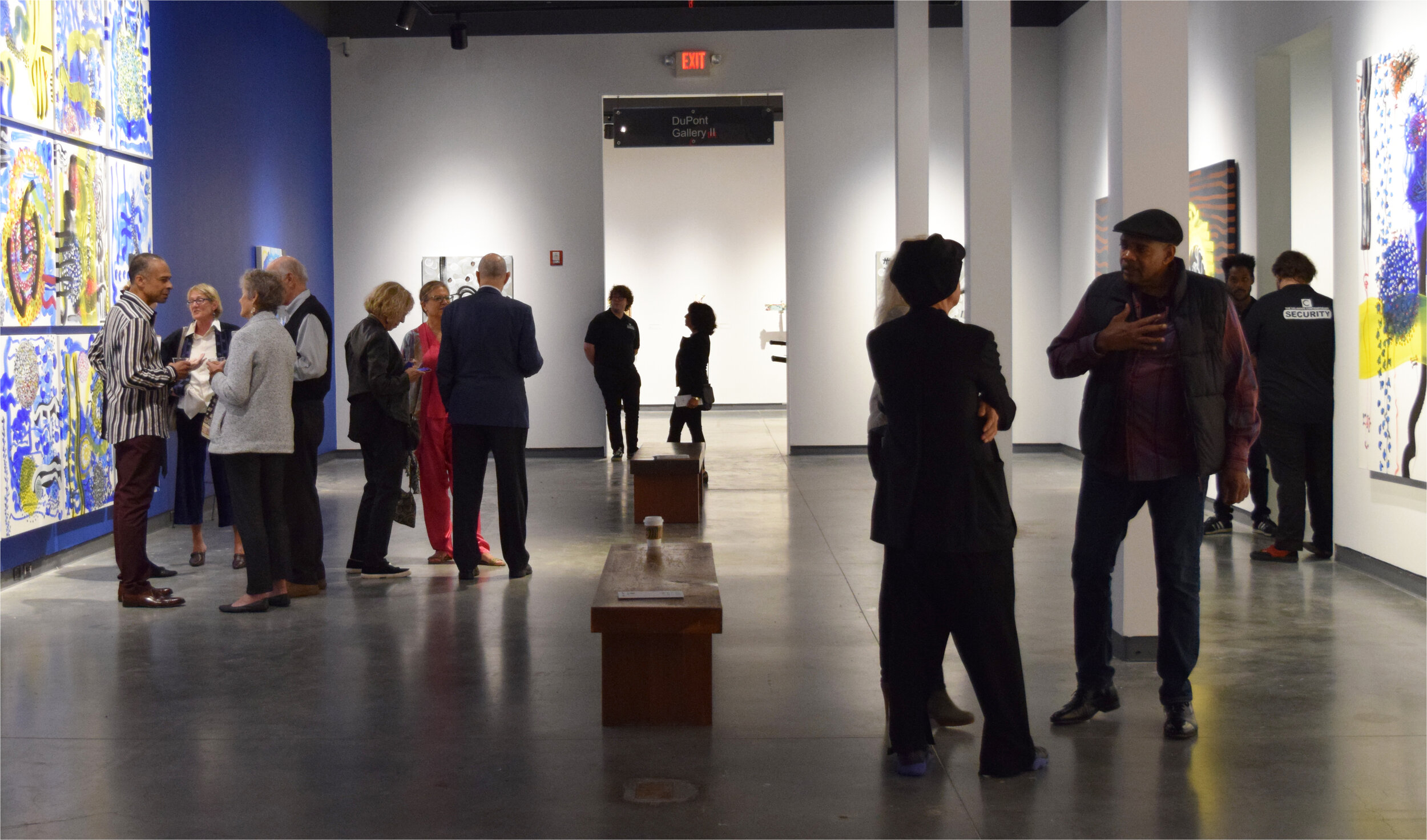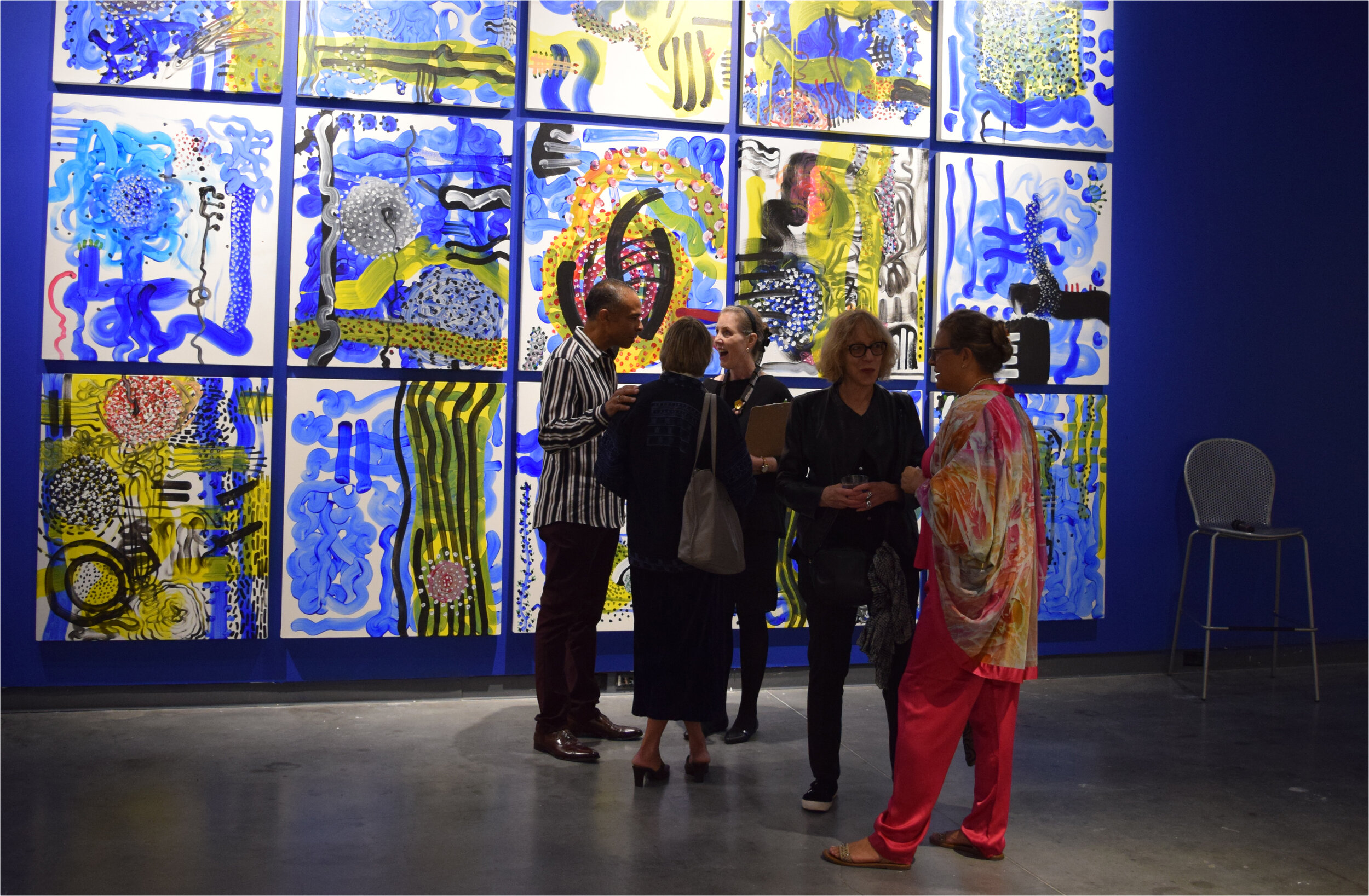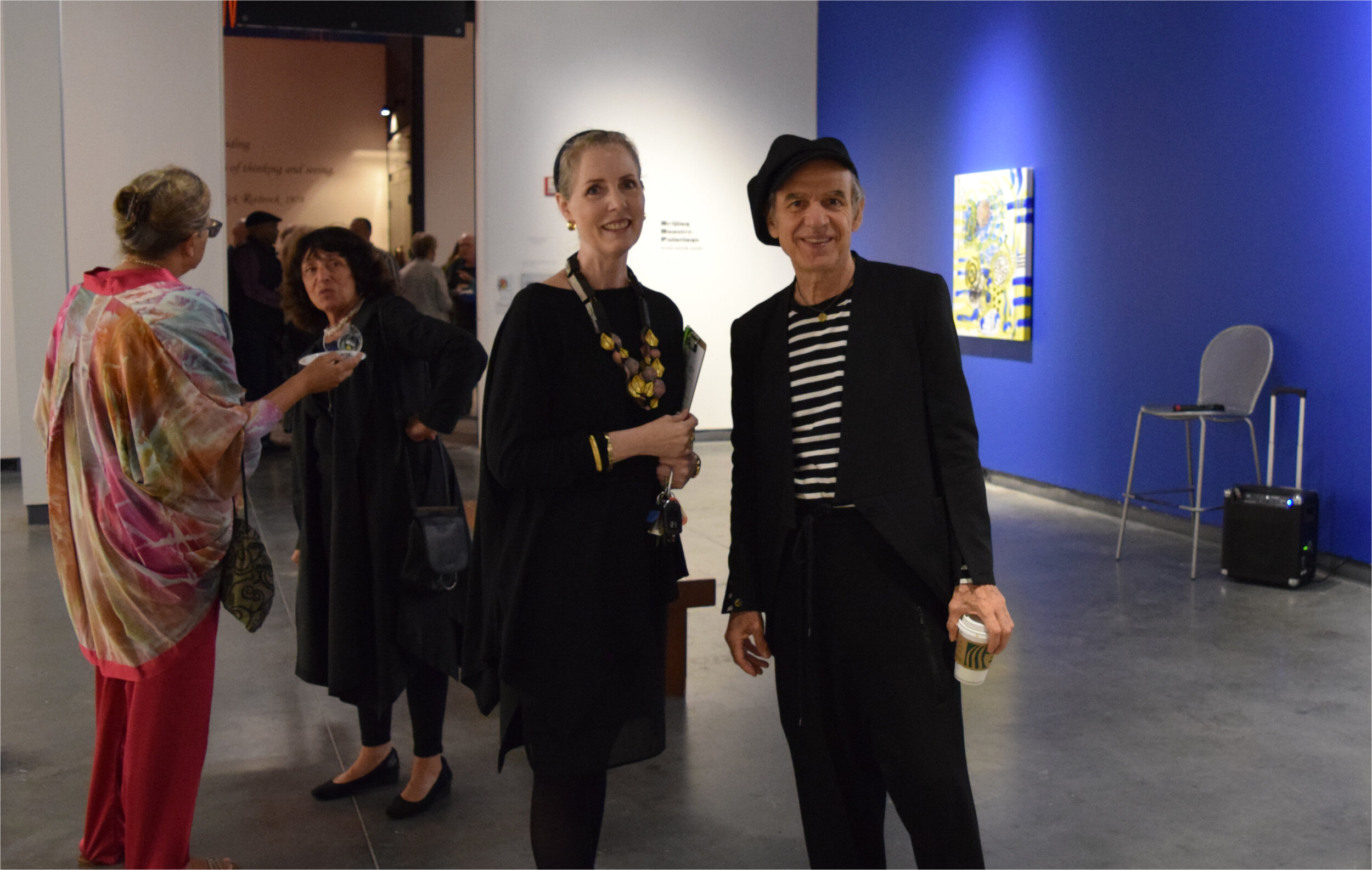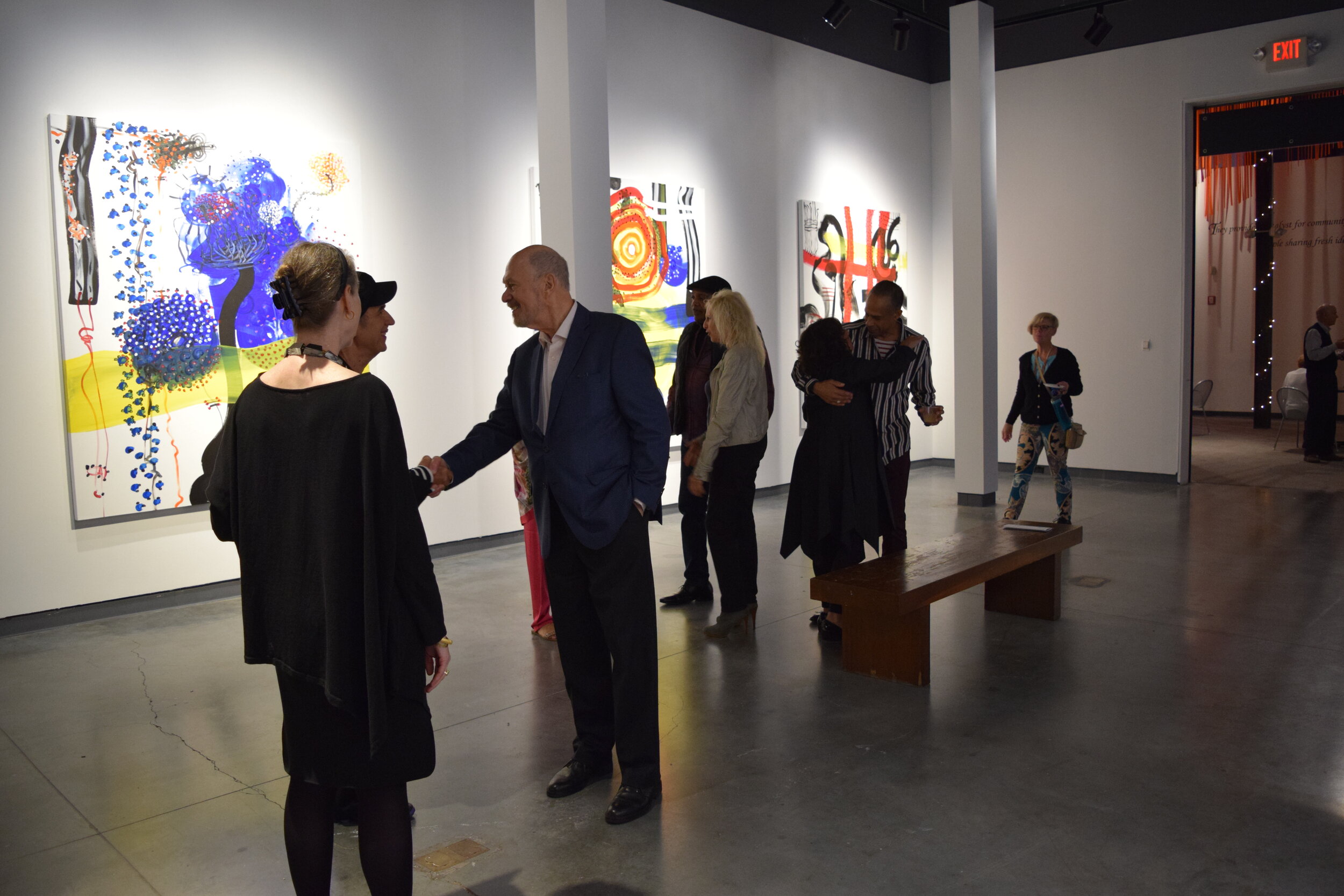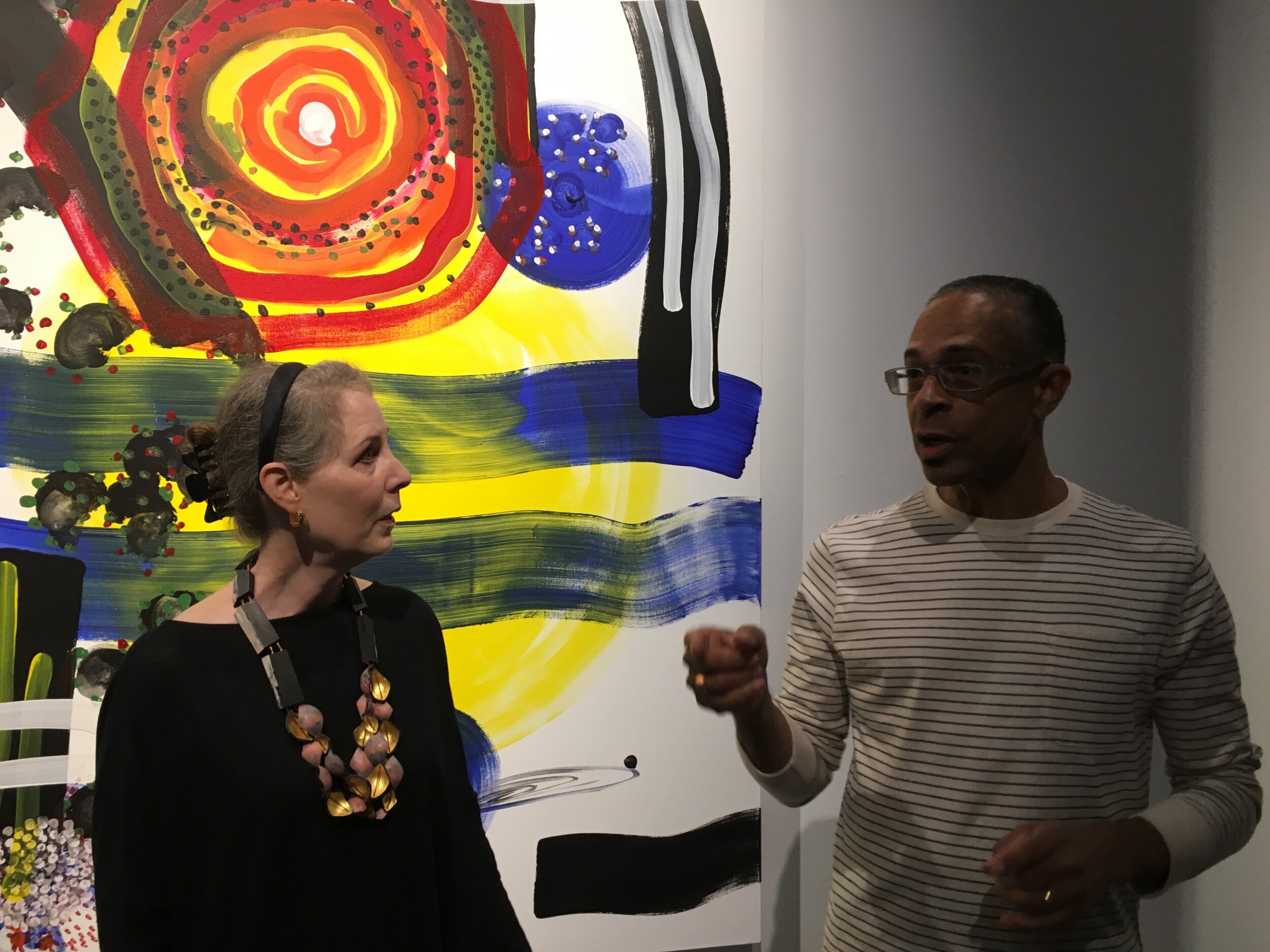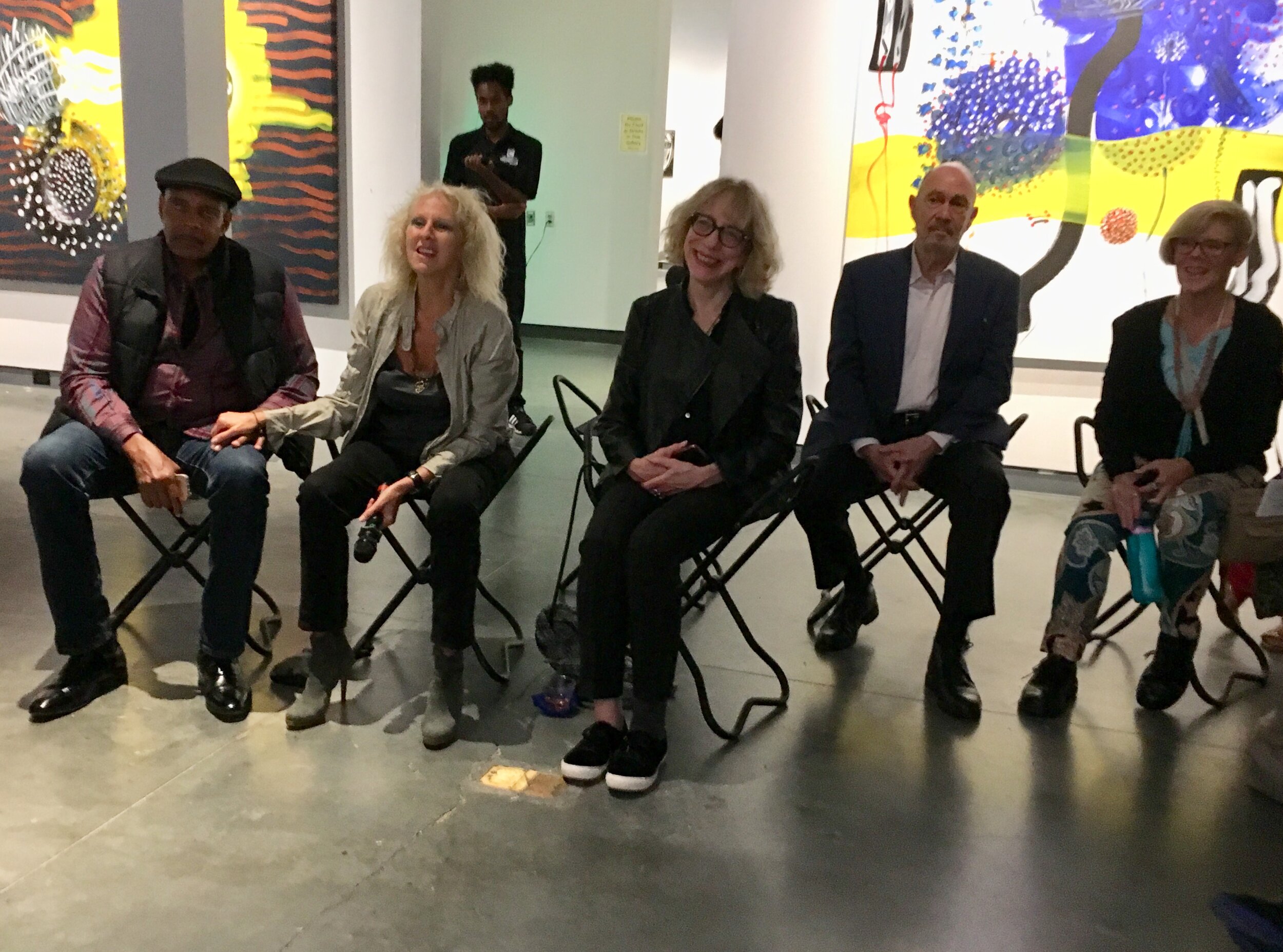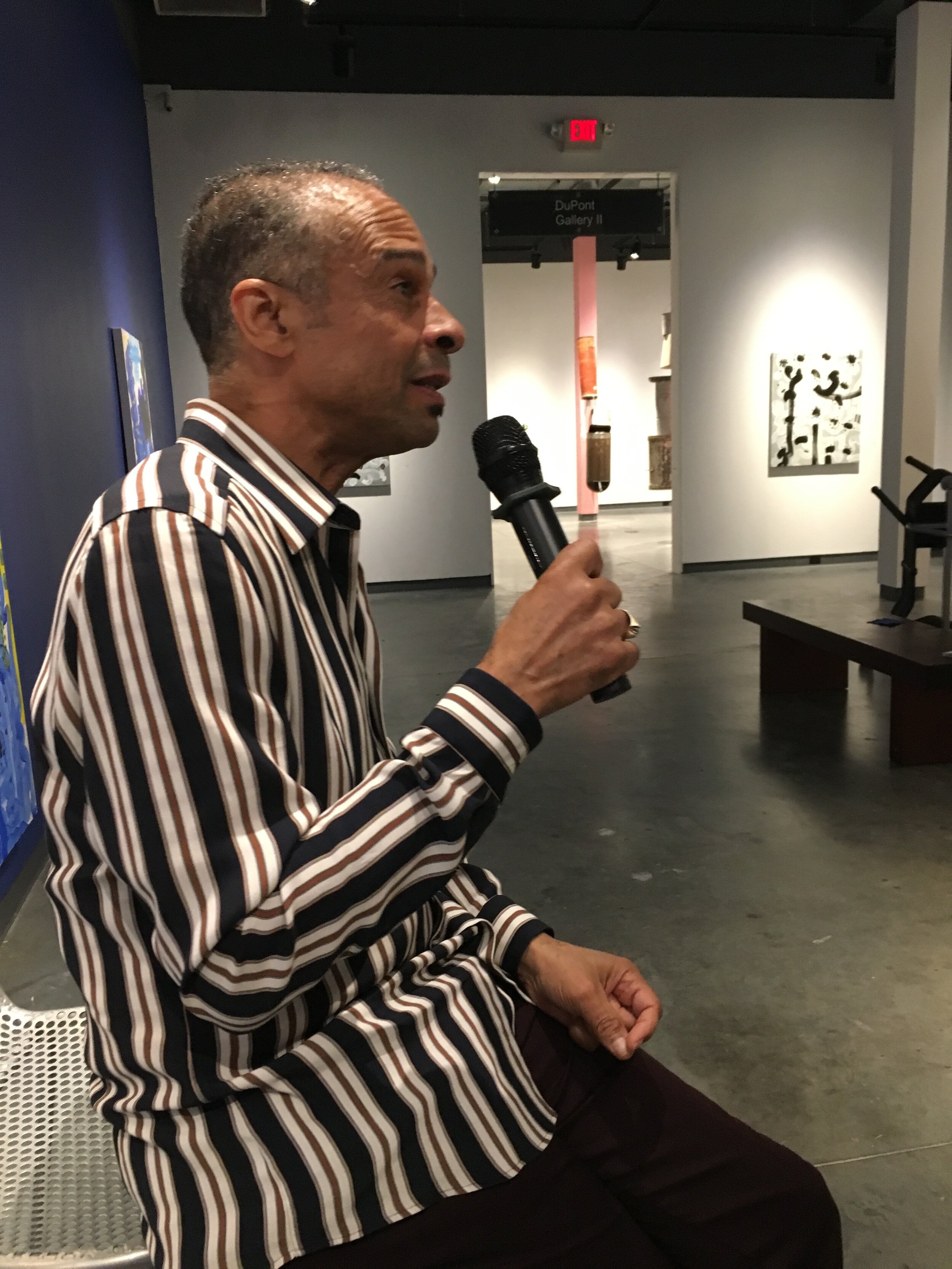Monk Time #6
Photo Credit: Peter Wayne Lewis Fine Art ©
Buddha Plays Monk #3
Photo Credit: Peter Wayne Lewis Fine Art ©
Support for this exhibition is generously provided by Rose Hall Developments.
Arts Events In and Around Delaware to Put on Your Calendar This Fall
Upcoming concerts, ballets, festivals and more.
BY AMY WHITE
Published: 08.19.2019
This fall will be nothing short of visionary at The Delaware Contemporary. Their first get of the season? Critical darling Peter Wayne Lewis, the internationally coveted Jamaican-born painter who has spent the past 10 years making his abstract art out of a studio in Beijing’s renowned artists’ district. The large-scale abstractions that color “Beijing Booster Paintings” are a cultural revolution: see influences of African American expressionists, Japanese sumi ink paintings, Chinese calligraphy and traditional American painting.
BEIJING BOOSTER PAINTINGS
Peter Wayne Lewis
October 4, 2019 - February 26, 2020
VIP Preview Reception:
October 3, 2019
Invite-only for current Friends of The Delaware Contemporary
Not a Friend? Learn more about Friends membership levels and benefits.
Public Reception:
October 4, 2019 | 5 - 9 PM during first Friday Art Loop
Beijing Booster Paintings is an ambitious exhibition by internationally collected and celebrated artist, Peter Wayne Lewis. For over a decade, Lewis has maintained and operated out of a studio in Beijing, China’s renowned 798 Art District. His large-scale abstractions are informed by artistic antecedents from American Abstract Expressionist painters such as Mark Rothko and Helen Frankenthaler, as much as Japanese sumi ink paintings and Chinese calligraphy by master painters like Ba Da Shan Ren. Tapping into both American and Asian traditions of painting, Lewis’ body of work makes a compelling case of cross-cultural aesthetics in an age of increasing globalization.
The overall valance of harmony laid bare on Lewis’ canvases are often punctuated by interruptions of dissonance that take protean forms. Lewis’ works are intended to be non-representational and expressions of his desire to manifest the omnipresent energies that dictate scientific concepts such as String Theory. For Lewis, paint is the vehicle with which to crystallize his considerations of physics, spirituality, and music; particularly jazz. Lewis creates a space where harmonious arrangements are forced to coexist with chaos. The comforts of pattern and balance are constantly put in peril on a visual plane where entropy reigns supreme. Which force of nature wins in the end may only be determined by the viewer.
Inspired by the world of jazz and musical greats such as Thelonious Monk, Lewis’ painterly creations possess a pervading volatility that directly speaks to the improvisational nature of jazz music. There exists an unquestionable tension that underscores Lewis’ work, one that is also inherent in the production and experience of jazz. In Lewis’ Buddha Plays Monk Suite, the tension between harmony and dissonance, a singular self-contained moment of expression, and an infinity of new experiences all teeter an ever-narrowing line that begets novel planes of awareness and understanding. The convoluted layers of paint beckon for viewers to discover and reawaken the rhythms within while navigating his work’s capricious twists and turns, flowing cascades, and sudden cessations.
Lewis’ works have been uniquely crafted due in large part to his oscillation and absorption of values and aesthetics between the East and the West. An artist with Jamaican roots, Lewis studied painting in the United States before taking on Eastern artistic interests in China. Lewis aims to collapse not only the modulations of time between the past and present traditions in his art, but also the varied artistic and intellectual histories that resonate with his identity as a Black American working to synthesize with the East.
Peter Wayne Lewis was born in Kingston, Jamaica West Indies and immigrated to the United States in 1962 where his parents made their home in Sacramento, California. He received his Master of Arts in painting in 1979 from San Jose State University in California and became an American citizen in 1983. He is a tenured Professor of Painting at Massachusetts College of Art and Design in Boston, Massachusetts and the former Chairman of Fine Art 2D department. He has exhibited extensively in Africa, the Caribbean, Europe, USA, and Asia. Exhibitions of recent paintings produced in his Beijing studio include MOCA-Museum of Contemporary Art, North Miami; UCCA-Ullens Center of Contemporary Art, Beijing, China; and China Art Museum, Shanghai, China. He is in numerous public and private collections. He currently resides in South Orange, New Jersey; Boston, Massachusetts; and Beijing, China.
Gallery Representations: JAYJAY-Contemporary Fine Art Sacramento, California; W MING ART, New York-Beijing-Shanghai, and SKOTO GALLERY, New York. Lewis currently serves on the board at White Box Gallery, New York.
-Michelle Dao, Curatorial Assistant
Carole Bieber & Marc Ham Gallery
彼得·韦恩·刘易斯:北京助推器 绘画展
展期:2019年10月4日 - 2020年2月26日
VIP 迎宾活动:2019年10月3日,晚 5 - 7点
开幕酒会:2019年10月4日,晚 5 - 9 点
美国特拉华当代艺术馆(The Delaware Contemporary)荣幸地宣布即将带来国际知名艺术家的大展——彼得·韦恩·刘易斯:助推器北京系列(Peter Wayne Lewis: Beijing Booster Paintings)。在过去的十多年里,刘易斯在中国的首都,北京,建立了自己的工作室并在那从事艺术创作。他的大型抽象作品受到了许多不同流派大师的影响,诸如美国抽象表现派画家马克·罗斯科(Mark Rothko)和海伦·弗兰肯塔勒(Helen Frankenthaler)、日本青墨画,以及中国书法和国画大家如八大山人。涉猎美洲和亚洲传统绘画,刘易斯的作品在这个日益全球化的年代里,是跨文化美学的一个重要范本。
刘易斯的画布上展现的和谐经常会被变化万千的元素打破。但不要误会了——刘易斯的作品意在以抽象形式表现弦理论无所不在的能量。对刘易斯来说,绘画是他呈现对物质、音乐(尤其是爵士乐)和精神层面思考的一种载体。在有限的画布上,刘易斯创造了一个空间,使得和谐有序与混乱得以共存。图案和平衡带来的视觉愉悦感在画面上呈现出很强的张力,其间穿梭着许多不确定性,最终是哪股力量的胜利,只能由观看者自己来决定。
受到爵士乐大师塞隆尼斯·蒙克(Thelonious Monk)的影响,刘易斯绘画形式创作中的普世无常对应了爵士乐的即兴属性。其作品中存在着不言自明的紧张感,仿佛是在创作和体验爵士乐时的固有感受。在他的《佛祖演奏蒙克(Buddha Plays Monk Suite)》系列中,有序和无序之间的博弈,无穷的新体验,主动性与被动性,都徘徊在逐渐模糊的界限上,从而产生了意识层面新的理解。绘画中的层次似乎在引导观众探索并唤醒自身的韵律感:在反复无常的曲折中,也在戛然而止的流动性里。
刘易斯作品中展现的独特创作方式,在很大程度上归功于他对东西方价值观和美学的共鸣与吸收。作为一个根植于牙买加的艺术家,刘易斯在美国学习了绘画,而后在中国受东方美学理念的感召。在他的艺术中,目的不仅是打破过去与现在的传统,还致力于表现丰富的艺术和思想进程,这些都与他作为一个善于融汇东方文化美国黑人身份产生了美妙的协奏。
彼得·韦恩·刘易斯出生于牙买加,1962年与父母于移居美国加州的萨克拉门托。1979年硕士毕业于加州圣何塞州立大学(San Jose State University in California),1983年成为美国公民。现任波士顿麻省艺术设计学院(Massachusetts College of Art and Design in Boston)的绘画系教授(Tenured Professor of Painting),曾经为美术平面部门(Fine Art 2D Department)前主席。他在非洲、加勒比地区、欧洲、美国、亚洲等地举行过展览。他在北京创作的系列作品,近期展览在北迈阿密当代艺术馆(MOCA-Museum of Contemporary Art North Miami)、北京尤伦斯当代艺术中心、上海中华艺术宫等机构举办。他的作品在美国境内外被许多藏家收藏。
现在工作、生活于北京、波士顿与新泽西的南桔县。
相关画廊有JAYJAY-Contemporary Fine Art Sacramento, California; WMING ART New York-Beijing-Shanghai;SKOTO GALLERY NEW YORK, LOOC ART。刘易斯目前在纽约白盒子画廊(White Box Gallery, New York)担任董事会成员。
- 米歇尔·道(Michelle Dao,策展助理)英文撰文
- 包雯璐(Wenlu Bao,策展助理)中文翻译
卡罗尔·比伯和马克·汉姆 展厅( Carole Bieber & Marc Ham Gallery)
VIP Preview Reception: October 3, 2019
INTERVIEW WITH PETER WAYNE LEWIS AND KATHRINE PAGE, GRETCHEN HUPFEL CURATOR OF CONTEMPORARY ART
KP: Your formative years were spent in Jamaica. What memories of that country are most pronounced for you?
PWL: THE JOYFULNESS OF THE PEOPLE, THE AMAZING LIGHT AND COLOR, THE FOLIAGE AND FOOD ALONG WITH THE RHYTHM OF THE SPIRIT THAT PERMEATES THOSE LANDS. IN THE 1950s WHEN I WAS GROWING UP, MENTO/SCA, JAZZ AND ROCK AND ROLL WAS BLASTED ON STREET RADIOS, WITH DANCE PARTIES. I REMEMBER HEARING LITTLE RICHARD, SEEING MOVIES AT THE THEATER WHERE MY MOTHER WORKED; ROGERS & HAMMERSTEIN SOUTH PACIFIC MOVIE IS STILL IN MY HEAD; I COULD NOT BELIEVE THIS WORLD THAT I WAS SEEING IN THE SOUTH PACIFIC.
KP: You moved from Jamaica, to Panama, California, New Jersey, Boston, you live in Beijing and you have at least three studios. What is it like splitting your practice between multiple spaces?
PWL: THIS IS NO PROBLEM; ALL IMMIGRANTS ARE KEENLY AWARE OF MIGRATION AND BEING OUT OF BALANCE; THIS FUELS THE CREATIVE SPIRIT WHICH IS NOT EASILY EXPLAINED. THE MIDDLE PASSAGE AND THE AFRICAN DIASPORA IN THE CARIBBEAN IS A DEFINING ISSUE FOR THE PRIMARY TRIBAL PEOPLE THERE THAT WERE BROUGHT AS SLAVES FROM GHANA, NIGERIA AND OTHER PARTS OF AFRICA. THE MIGRATION OF THE SPANISH, THE BRITISH EMPIRE IN JAMAICA WITH ITS HISTORY AS BEING ONE OF THE MOST WICKEDEST PLACES IN THE WORLD, DUE TO ITS USE AS A PIRATE HAVEN; HENRY MORGAN ETC. THIS HISTORICAL SITUATION STILL PERMEATES THE CULTURE OF JAMAICA THROUGH ISSUES OF SURVIVAL UNDER DRASTIC CIRCUMSTANCES.
KP: What impact has this had on the way you approach your work?
PWL: ONE’S EXPERIENCES OF THE WORLD ALWAYS INFLUENCES HOW ONE SEES IT AND NAVIGATES THROUGH ITS VARIOUS GUISES. I DO NOT DELIBERATELY TRY TO CREATE PAINTINGS THAT TELL THIS NARRATIVE; THE WORK IN AND OF ITSELF, DOES REPRESENT WHO AND WHAT I AM. THIS CREATES A SENSE OF DESPERATION, EDGINESS, TEMPORAL ISSUES ABOUND WITH MY WHOLE BEING AWARE OF THE LIMITS OF WHAT CAN BE DONE.
KP: What is the ideal studio?
PWL: ANY PLACE WHERE ONE CAN WORK WITH BIG SPACE AND WALLS ALONG WITH A MINIMUM OF HUMAN COMFORTS.
KP: It’s universally known that the life of a painter means many hours alone in the painting process.
PWL: I DO NOT BELIEVE THAT TO BE A TRUISM, MANY DIFFERING MODES OF CREATION EXIST; PUBLIC PERFORMANCES SINCE THE BEGINNING OF TIME AND PICTURE MAKING. MY THOUGHT ABOUT THE ORIGINS OF PAINTINGS REVOLVES AROUND ITS PERFORMATIVE, RITUAL NATURE. PERSONALLY, I DO WORK PRIMARILY ALONE WITH MUSIC, WHICH I BELIEVE TO BE A LIVING ENTITY ALSO INVENTED BY HUMAN BEING TO MAINTAIN THEIR SANITY.
KP: Do you recommend global peregrination for all artists?
PWL: WE ARE ALL ON A JOURNEY OF LIFE AND WHETHER ITS AROUND THE BLOCK OR AROUND THE WORLD, THERE IS ALWAYS A RISK. THE HUMAN IMAGINATION IS FILLED WITH SPIRITUAL JOURNEYS NOT NECESSARILY ALWAYS MOVING ONES PHYSICAL BODIES, WHICH IMPACT US NONE-THE-LESS. ARTISTS HISTORICALLY SEEMS TO BE QUITE NOMADIC ALWAYS SEEKING OTHER LANDS FOR INSPIRATION.
KP: Talk about how it relates to String Theory?
PWL: STRING THEORY IS A JOURNEY OF THE HUMAN IMAGINATION CREATING A METAPHOR FOR WHAT LIFE IS AND HOW IT WAS CREATED. BUT, IT IS IN FACT A FEEBLE ATTEMPT TO TRY TO EXPLAIN THE MAJESTY OF CREATION OF THIS COSMIC WORLD. I JUST READ THAT VOYAGER 2 HAS JUST REACHED INTERSTELLAR SPACE AFTER TRAVELING 47 YEARS AND NOW BILLIONS OF MILES FROM EARTH.
KP: This series was produced wholly in China. How does living in China inform your work?
PWL: ALL HUMAN BEINGS ARE AFFECTED BY WHERE THEY LOCATE THEIR BODIES; THE THINGS THAT WE EAT, THE PEOPLE THAT WE MEET, THE EXPERIENCES UNIMAGINED. I AM INVOLVED IN CULTURAL PRODUCTION FROM MY PERSONAL POINT OF VIEW NO DOUBT, BUT MY TIMES IN BEIJING IS JUST A BACKDROP FOR MY AESTHETIC EXPLORATIONS. I AM NOT SEEKING DIRECT INFLUENCES OF AN ASIAN POINT OF VIEW; BUT RATHER INSTILLING MY SENSIBILITIES THROUGH OUT MY INTERACTIONS WITH DIFFERING COMMUNITIES THAT I ENCOUNTER IN A HUMBLE WAY. ITS MY MODUS OPERANDI WHICH I HAVE FOLLOWED THROUGH DIFFERENT ARTISTIC EXPERIENCES IN, GERMANY, ITALY, FRANCE, AFRICA, THE CARIBBEAN ETC. WHEN I DID A RESIDENCY IN ESCHLKAM, GERMANY I WAS ASKED A SIMILAR QUESTION AND BASICALLY THESE SORT OF EXPERIENCES MANIFESTS ITSELF AS TIME GOES BY. IN A FUNNY WAY, THE BLUE THAT IS GENERALLY USED ON WALLS FOR MY EXHIBITIONS PERHAPS EXTENDS FROM MY EXPERIENCE IN BAVARIA, GERMANY AND THEIR FLAG.
KP: Does the meaning of your art change when it’s shown in a different culture?
PWL: THE MEANINGS DO NOT CHANGE FOR ME, BUT THE AUDIENCE RESPONSE IS ALWAYS COLORED BY THEIR CULTURAL EXPERIENCES AND VISION WHICH IS USED TO MEDIATE THE WORLD OF APPEARANCES.
KP: Are there political or spiritual underpinnings?
PWL: ALL ART IS POLITICAL IN ITS NATURE BUT NOT NECESSARILY IN AN INSTRUMENTAL WAY; SAY WORKING AS AN ORGAN OF A STATE FOR PROPAGANDA PURPOSES. WITH REGARD TO SPIRITUAL UNDERPINNINGS; SPIRITUALITY CONNOTES A COVENANT WITH HIGHER FORCES THAT FALL OUTSIDE OF NORMAL HUMAN VISION AND EXPERIENCES; I DO BELIEVE THAT ARTISTS ARE TRYING TO FIND SOMETHING GREATER THAN THEMSELVES SO PERHAPS THAT’S A QUEST FOR THE SPIRITUAL.
KP: Many of your artistic antecedents’ work is fundamentally rooted in music to visualize what music does sonically. I think of artists like Stuart Davis, Paul Klee, and Kandinsky who once said --”art should foster an overwhelming, multi-sensory experience in the viewer.” Is there a relationship between color and music or symbolism that could be readily apparent to the audience?
PWL: IN A CURSORY FASHION YES. THE LITERATURE OF A PAINTING CAN DELIBERATELY TRY AND EQUATE COLOR TO SOUND BUT IN REALITY THEY ARE SEPARATE BODILY EXPERIENCES. WE HEAR SOUND THROUGH OUR EARS AS WELL AS OUR ENTIRE BODIES INCLUDING OUR SKIN THAT WRAPS OUR ORGANS.
WITH REGARD TO THE AUDIENCE; I AM NOT AN ILLUSTRATOR PROFESSING A SINGULAR WAY TO ASSIGN MEANING THROUGH WHAT IS ESSENTIALLY AN OCULAR EXPERIENCE.
KP: In his, “For the Love of Music,” John Mauceri writes, “Music is [always] there.. it waits for you. You can come to it any point in your life….[it’s] always illuminating who you are..It has an unpredictable way of entering your brain.” What draws you to jazz?
PWL: I AGREE WITH THE DESCRIPTION OF WHAT AND HOW MUSIC AFFECTS US. JAZZ -- AMERICAS CLASSICAL MUSIC -- WAS INTRODUCED TO ME BY MY FATHER HERMAN B LEWIS A CLASSICALLY TRAINED PIANIST WHO GRADUATED FROM THE CONSERVATORY OF MUSIC IN PANAMA.
KP: When did it enter your brain, and how has it illuminated who you are?
PWL: MUSIC IS ONE OF THE GREATEST GIFTS THE GODS GAVE US. THE MOST BEAUTIFUL SOUND IS THE RHYTHM OF THE COSMOS AND MOVEMENT OF THE HEAVENS.
KP: Talk about the dynamics of space in this gallery.
PWL: THE SPACE IN THE GALLERY AFFECTS OUR EXPERIENCES HENCE MY REQUEST TO PAINT A WALL BLUE; IT ACTIVATES THE SPACE AND SETS A MOOD. THE SINGULARITY OF A PAINTING IS ONLY A PART OF THE EXPERIENCE, IT IS A WHOLE-BODY EXPERIENCE WHEN ONE IS CONFRONTED BY ANOTHER HUMAN BEINGS CREATIVE PROCESS. PAINTINGS ARE EVIDENCE OF A THOUGHT PROCESS MANIFESTING ITS FORM PICTORIALLY AND LINGUISTICALLY.
KP: What excites you?
PWL: LIFE EXCITES ME.
KP: What do you hope the relationship will be between the artwork and the viewer?
PWL: HOPEFULLY AFFECTING THE SPECTATOR IN SOME SORT OF A FASHION; BUT THE AMOUNT OF TIME THAT A SPECTATOR CAN DEVOTE REALLY MAKES A DIFFERENCE. RAPHAEL PAINTING AT THE KUNST HISTORIA MUSEUM IN VIENNA; MADONNA IN THE MEADOW 1506 STOPPED ME IN MY TRACKS AND I SPEND THE AFTERNOON CONTEMPLATING THIS WORK FOR MANY HOURS. IM SURE THE SECURITY GUARDS THOUGHT I WAS TRYING TO STEAL THE PAINTING BECAUSE I STAYED IN THE ROOM SO LONG! LOL.
KP: Comment on the grid of 15. How does the grid accentuate the individual vs. the whole?
PWL: THE GRID IS A PRIMARY STRUCTURE THAT TRIES TO CREATE ORDER IN ONES LIFE , COMMUNITY, CULTURE , CIVILIZATIONS. MY USE OF THE GRID IS NOT ABOUT THE BAUHAUS BUT RATHER IN REFERENCE TO THE FORM APPEARING IN ANCIENT CAVE DWELLINGS AROUND THE WORLD. IT INDICATES CONSCIOUSNESS THROUGH OUT DELIBERATE MEANS OF SOMETHING THAT IS NOT NATURALLY OCCURRING IN NATURE; PERHAPS A BIT ARROGANT TRYING TO REORDER NATURE WHICH IS IMPOSSIBLE.
KP: Talk about the scale of your paintings. How does scale affect the viewers’ experience?
PWL: THE SCALE IS ABOUT DWARFING THE VIEWER BY COMPRESSING THE SPACE WHERE ONE HAS TO MOVE BACK AND FORTH TO SEE THE WHOLE; A BIT LIKE BREATHING. MARK ROTHKO USED A SIMILAR STRATEGY BUT DELIBERATELY WANTED THE VIEWER TO BE ABOUT 16 INCHES FROM THE PAINTING WHERE ONES PERIPHERAL VISON IS LOST AND PHYSICAL BALANCE IS LOST; THAT WAS HIS IDEA.
KP: How does it impact the mobility of the work?
PWL: MY JOB IS TO MAKE THE WORK AND IT’S THE GALLERY OR MUSEUM DUTY TO DEAL WITH THE LOGISTICS. I’M JUST MAKING THE THINGS HOWEVER WORKING IN CHINA WAS DELIBERATELY DUE TO WANTING TO SCALE UP AND IT WAS COST EFFECTIVE TO DO THAT.
KP: Do you think your paintings exist outside the confines of the canvas? Is there a meta-visualization? Are your works intended as places of contemplation? Is there room in the 21st century for contemplation? What emotions drive the composition?
PWL: THE ANSWER IS YES TO ALL THE QUESTIONS. EMOTIONS DRIVE THE MAKING OF ART. IT EXTENDS FROM THE PERSON NATURALLY. A NON-SENTIENT MACHINE DEVOID OF SPIRIT AND BEING THUS FAR CAN CREATE PICTURE BUT ART COMES FROM THE DEEPEST RECESSES OF HUMAN CONSCIOUSNESS.
KP: What are some ways you introduce the idea of abstraction and improvisation to the students still in the nacency of discovering their vision?
PWL: ALL PICTORIAL IMAGES CREATED BY MAN/WOMAN ARE AN ABSTRACTION OF LIFE WHICH IS THE ONLY REAL THING THAT WE KNOW. DESCARTES: “I THINK THEREFORE I AM” AS A METAPHOR.
KP: How has technology impacted your curriculum, especially in relation to teaching painting?
PWL: TECHNOLOGY IS THE SINGLE FORCE THAT HAS ALWAYS PROPELLED THE ARTS FORWARD FOR GOOD OR BAD. PAINTING IS A TECHNOLOGY THAT WAS INVENTED BY OUR EARLY ANCESTORS TO ASSIGN MEANING TO WHAT WE WERE SEEING AND EXPERIENCING, IT MADE US MORE CONSCIOUS IN OUR JOURNEY OF BECOMING A HUMAN BEING. CRITICALLY ITS MAIN FUNCTION WAS TO KEEP THE HUMAN SPECIES FROM GOING EXTINCT.
PETER WAYNE LEWIS © 11/17/2019






